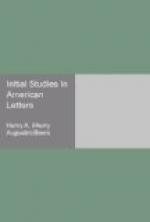In the absence of schools the higher education naturally languished. Some of the planters were taught at home by tutors, and others went to England and entered the universities. But these were few in number, and there was no college in the colony until more than half a century after the foundation of Harvard in the younger province of Massachusetts. The college of William and Mary was established at Williamsburg chiefly by the exertions of the Rev. James Blair, a Scotch divine, who was sent by the Bishop of London as “commissary” to the Church in Virginia. The college received its charter in 1693, and held its first commencement in 1700. It is perhaps significant of the difference between the Puritans of New England and the so-called “Cavaliers” of Virginia, that while the former founded and supported Harvard College in 1636, and Yale in 1701, of their own motion and at their own expense, William and Mary received its endowment from the crown, being provided for in part by a deed of lands and in part by a tax of a penny a pound on all tobacco exported from the colony. In return for this royal grant the college was to present yearly to the king two copies of Latin verse. It is reported of the young Virginian gentlemen who resorted to the new college that they brought their plantation manners with them, and were accustomed to “keep race-horses at the college, and bet at the billiard or other gaming-tables.” William and Mary College did a good work for the colony, and educated some of the great Virginians of the Revolutionary era, but it has never been a large or flourishing institution, and has held no such relation to the intellectual development of its section as Harvard and Yale have held in the colonies of Massachusetts and Connecticut. Even after the foundation of the University of Virginia, in which Jefferson took a conspicuous part, Southern youths were commonly sent to the North for their education, and at the time of the outbreak of the civil war there was a large contingent of Southern students in several Northern colleges, notably in Princeton and Yale.
Naturally, the first books written in America were descriptions of the country and narratives of the vicissitudes of the infant settlements, which were sent home to be printed for the information of the English public and the encouragement of further immigration. Among books of this kind produced in Virginia the earliest and most noteworthy were the writings of that famous soldier of fortune, Captain John Smith. The first of these was his True Relation, namely, “of such occurrences and accidents of note as hath happened in Virginia since the first planting of that colony,” printed at London in 1608. Among Smith’s other books the most important is perhaps his General History of Virginia (London, 1624), a compilation of various narratives by different hands, but passing under his name. Smith was a man of a restless and daring spirit, full of resource, impatient of contradiction, and




